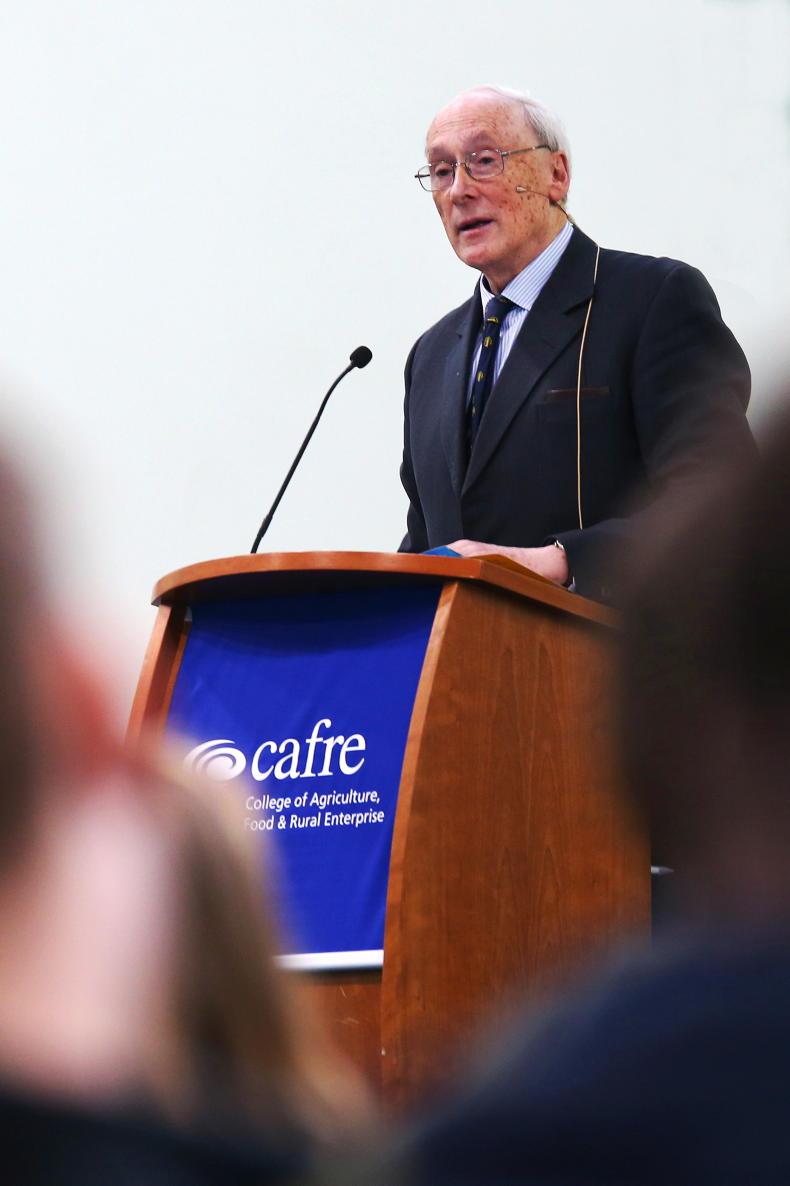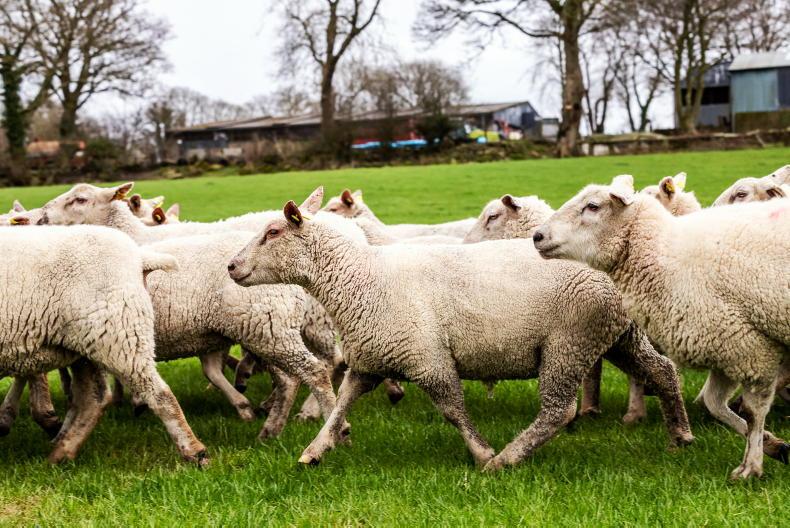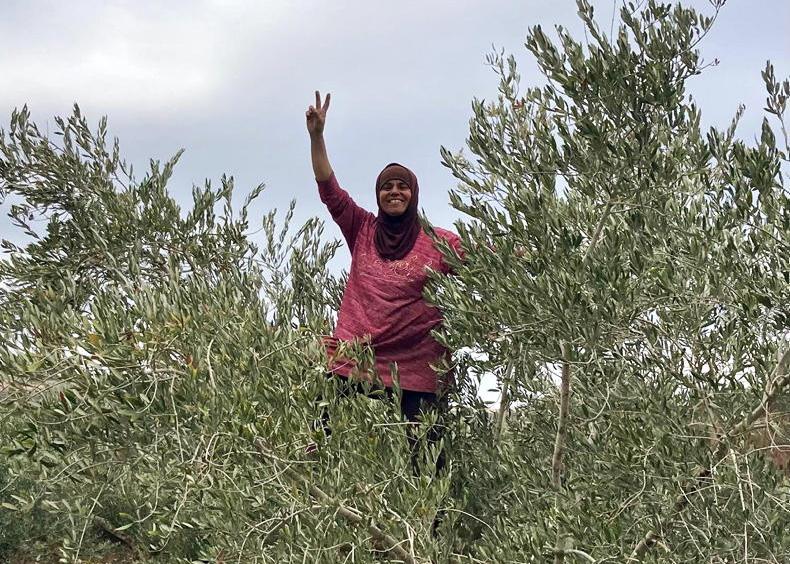Grazing sheep on arable land for up to nine months of the year helps crops to recycle nutrients, removes disease, regulates growth and ultimately, delivers a more profitable system, English farmer Ed Horton told last Thursday’s arable conference at Greenmount.
Horton, who runs a large-scale enterprise across 6,000 acres of arable land and 3,000 acres farmed under contract in the Cotswolds area, described his system as a “hybrid” between conventional and organic.
“We have a huge focus on removing artificial inputs, purely from a risk-removal point of view. I take great delight in having a huge amount of biodiversity on the farm, while still running a large commercial farming operation around it,” he said.
Over the years, Horton has gradually moved away from ploughing, with most commercial crops direct-drilled, including into cover crops. He is a strong advocate of the use of cover crops and the benefits they bring in terms of preventing nutrient loss during autumn and winter, as well as helping soil biology. The cover crops are also used to finish lambs.
“A lot of cover crops are sometimes over-complicated. I try to keep it simple with a three-way mix of mustard, buckwheat and phacelia,” he said.
While some glyphosate is still used on the farm, Horton mainly relies on grazing and frost damage to kill off the crop ahead of spring planting.
He also direct-drills into cover crops late in the autumn, relying on mechanical destruction, although he said it can sometimes turn into a “disaster” if there is no subsequent frost.
Oilseed rape
Horton has also looked into the benefits of growing companion crops, including with oilseed rape (OSR). Clovers are added to the mix, as they benefit the soil and provide a high protein diet when the crop is grazed by sheep later in the year, while buckwheat helps shade the OSR from flea beetle attack.
“We are insecticide free for 10 years,” said Horton.
Once the sheep have finished grazing OSR, they move on to the cover crops and from January through to mid-March graze winter barley and winter wheat. As well as a 1,500 ewe flock, there is a 180-cow pedigree Shorthorn herd on the farm. Some of the cows are out-wintered on cover crops, while those inside create farmyard manure. In addition, there is the slurry available from a large pig finishing unit (5,000 pig places).
“That slurry provides 65% of our nitrogen, all our phosphorus and potassium and two thirds of our sulphur on the home farm,” said Horton.
Technology
While grazing benefits weed management, five years ago the farm invested in a 3D camera-guided hoe and that has allowed herbicide usage to be cut by around 75%.
“We now have three of them. It can look aesthetically damaging and it is slow, but there is zero resistance [from the likes of Blackgrass] and it is far more targeted than spraying,” said Horton.
AFBI research puts value on manures
A three-year trial led by researchers at AFBI Crossnacreevy has highlighted the potential economic value of manures in arable situations.
The trial, which concluded at harvest in 2023, looked at the impact of different sources of organic matter on spring barley yield, nutrient cycling and soil health.
In total, 14 treatments and two controls were assessed in the work conducted on a farm in Ballywalter, Co Down, explained Dr Lisa Black from AFBI. Manures were applied by hand, ahead of ploughing each spring.
The rates of organic matter used were within the limits set by the NI Nutrients Action Programme and RB209, with nutrients topped up with artificial inputs to meet the spring barley requirements set out in RB209. In general, the organic manures supplied about 60% of nitrogen requirements, confirmed Black.
Preliminary analysis of results showed there was no significant differences across treatments in measurements used to assess soil biology and “not a huge variation” in cumulative yields across the three years.
“The result was not a huge surprise, as we were topping up with chemical fertiliser,” said Black.
However, the field started off with phosphorus (P) and potassium (K) indexes at 1 and by the third year most treatments had raised K Index to over 1 and all treatments had P indexes of at least 2. The likes of pig slurry, cattle slurry and layer manure all raised P indexes by a significant amount when compared to the unfertilised control.
To put an economic value on each source of organic matter, fertiliser prices at January 2024 were used and a barley price of £200/t assumed. Layer manure has the highest value at £12.67/t, with cattle slurry at £5.79/t, pig slurry at £5.41/t, cattle farmyard manure at £4.80/t and untreated digestate at £2.88/t.

Matt Dempsey gave the keynote address at the event. \ Houston Green
Stablising incomes for crop growers
Some form of crop insurance programme is likely to be among the main recommendations put to Government by a high-level group tasked with developing a plan to increase the area of tillage in the Republic of Ireland.
Chaired by Matt Dempsey, the Food Vision Tillage Group, was established by Irish Farm Minister Charlie McConalogue in May 2023, with its remit to produce a detailed plan and recommendations to sustainably grow the sector to 400,000ha (1m acres) by 2030. In 2022, there were approximately 348,000ha of crops grown.
In the keynote address at last Thursday’s event, Dempsey said the group has looked at crop insurance schemes, including in the US, where government helps subsidise a programme that helps protect growers against extremes of weather or volatile prices.
“One of the more important policy changes that I think we will recommend is for some form of income stabilisation scheme. When we discussed this with Minister McConalogue, he was amenable to the idea and asked us to get some more information,” said Dempsey.
He warned that without a change in approach the tillage sector faces further consolidation and potentially a decline in the area sown out in crops.
But even if a scheme is introduced, there are other pressures on the sector, including high demand for land from dairy farmers impacted by changes to the upper limit for manure nitrogen, which has been cut from 250kg to 220kg/ha.
As a result, the 400,000ha tillage target for 2030 is likely to be challenging, acknowledged Dempsey.
Feasibility
Other recommendations likely to be included in the final report by the Tillage Group include that a feasibility study should be undertaken on the potential to build an oilseed rape processing plant in Ireland (most of the crop goes to the UK for processing).
The group would also like to see “a revamped Tillage Incentive Scheme”, which would offer long-term support and a strong environmental focus. The scheme was introduced in 2022, with the aim to encourage farmers to maintain or increase the area in crops.
Where growers maintain crop areas at the same level as the previous year they are eligible for a €200/ha payment. For newly converted tillage land, the payment rate is €400/ha.
EU policy targets unlikely to be met
The EU’s flagship ‘Farm to Fork’ strategy released in May 2020 has faced significant opposition and its main targets look “incredibly unlikely” to be achieved, maintained Jenny Brunton from the British Agriculture Bureau (BAB).
Included within the policy are 2030 targets to have 25% of EU agricultural land farmed organically, while also cutting overall fertiliser use by 20% and pesticide use by 50%.
According to Brunton, record levels of inflation, driven in part by the war in Ukraine, have brought a wider recognition that Europe still needs to produce food. As a result, there has been a push-back against the policy by MEPs and ministers from many EU member states.
“It is a challenging time for Europe. We are seeing large scale farmer protests for a mix of reasons. In general, we are seeing a lot of frustration across the continent and it doesn’t take much for the French to join in,” she said.
For farmers further east, she said anger is growing at tariff-free imports of grain and other crops being allowed into the EU from Ukraine.
“We do support Ukraine, but we would like to see protections in place for vulnerable sectors,” said Brunton.
There is also concern among Europe’s farmers about EU expansion and the possibility of the likes of Ukraine being admitted, given it would then potentially become the largest recipient of CAP money.
Brexit
Since Brexit, much of the work done by the Brussels-based BAB office, is trying to re-build relationships “and make sure our voice is heard,” said Brunton.
“We do represent the UK, but a large part of our work now is flagging issues impacting NI,” she added.
Read more
An even crop is more important than a good plant count
Glyphosate resistance, not all products are equal
Grazing sheep on arable land for up to nine months of the year helps crops to recycle nutrients, removes disease, regulates growth and ultimately, delivers a more profitable system, English farmer Ed Horton told last Thursday’s arable conference at Greenmount.
Horton, who runs a large-scale enterprise across 6,000 acres of arable land and 3,000 acres farmed under contract in the Cotswolds area, described his system as a “hybrid” between conventional and organic.
“We have a huge focus on removing artificial inputs, purely from a risk-removal point of view. I take great delight in having a huge amount of biodiversity on the farm, while still running a large commercial farming operation around it,” he said.
Over the years, Horton has gradually moved away from ploughing, with most commercial crops direct-drilled, including into cover crops. He is a strong advocate of the use of cover crops and the benefits they bring in terms of preventing nutrient loss during autumn and winter, as well as helping soil biology. The cover crops are also used to finish lambs.
“A lot of cover crops are sometimes over-complicated. I try to keep it simple with a three-way mix of mustard, buckwheat and phacelia,” he said.
While some glyphosate is still used on the farm, Horton mainly relies on grazing and frost damage to kill off the crop ahead of spring planting.
He also direct-drills into cover crops late in the autumn, relying on mechanical destruction, although he said it can sometimes turn into a “disaster” if there is no subsequent frost.
Oilseed rape
Horton has also looked into the benefits of growing companion crops, including with oilseed rape (OSR). Clovers are added to the mix, as they benefit the soil and provide a high protein diet when the crop is grazed by sheep later in the year, while buckwheat helps shade the OSR from flea beetle attack.
“We are insecticide free for 10 years,” said Horton.
Once the sheep have finished grazing OSR, they move on to the cover crops and from January through to mid-March graze winter barley and winter wheat. As well as a 1,500 ewe flock, there is a 180-cow pedigree Shorthorn herd on the farm. Some of the cows are out-wintered on cover crops, while those inside create farmyard manure. In addition, there is the slurry available from a large pig finishing unit (5,000 pig places).
“That slurry provides 65% of our nitrogen, all our phosphorus and potassium and two thirds of our sulphur on the home farm,” said Horton.
Technology
While grazing benefits weed management, five years ago the farm invested in a 3D camera-guided hoe and that has allowed herbicide usage to be cut by around 75%.
“We now have three of them. It can look aesthetically damaging and it is slow, but there is zero resistance [from the likes of Blackgrass] and it is far more targeted than spraying,” said Horton.
AFBI research puts value on manures
A three-year trial led by researchers at AFBI Crossnacreevy has highlighted the potential economic value of manures in arable situations.
The trial, which concluded at harvest in 2023, looked at the impact of different sources of organic matter on spring barley yield, nutrient cycling and soil health.
In total, 14 treatments and two controls were assessed in the work conducted on a farm in Ballywalter, Co Down, explained Dr Lisa Black from AFBI. Manures were applied by hand, ahead of ploughing each spring.
The rates of organic matter used were within the limits set by the NI Nutrients Action Programme and RB209, with nutrients topped up with artificial inputs to meet the spring barley requirements set out in RB209. In general, the organic manures supplied about 60% of nitrogen requirements, confirmed Black.
Preliminary analysis of results showed there was no significant differences across treatments in measurements used to assess soil biology and “not a huge variation” in cumulative yields across the three years.
“The result was not a huge surprise, as we were topping up with chemical fertiliser,” said Black.
However, the field started off with phosphorus (P) and potassium (K) indexes at 1 and by the third year most treatments had raised K Index to over 1 and all treatments had P indexes of at least 2. The likes of pig slurry, cattle slurry and layer manure all raised P indexes by a significant amount when compared to the unfertilised control.
To put an economic value on each source of organic matter, fertiliser prices at January 2024 were used and a barley price of £200/t assumed. Layer manure has the highest value at £12.67/t, with cattle slurry at £5.79/t, pig slurry at £5.41/t, cattle farmyard manure at £4.80/t and untreated digestate at £2.88/t.

Matt Dempsey gave the keynote address at the event. \ Houston Green
Stablising incomes for crop growers
Some form of crop insurance programme is likely to be among the main recommendations put to Government by a high-level group tasked with developing a plan to increase the area of tillage in the Republic of Ireland.
Chaired by Matt Dempsey, the Food Vision Tillage Group, was established by Irish Farm Minister Charlie McConalogue in May 2023, with its remit to produce a detailed plan and recommendations to sustainably grow the sector to 400,000ha (1m acres) by 2030. In 2022, there were approximately 348,000ha of crops grown.
In the keynote address at last Thursday’s event, Dempsey said the group has looked at crop insurance schemes, including in the US, where government helps subsidise a programme that helps protect growers against extremes of weather or volatile prices.
“One of the more important policy changes that I think we will recommend is for some form of income stabilisation scheme. When we discussed this with Minister McConalogue, he was amenable to the idea and asked us to get some more information,” said Dempsey.
He warned that without a change in approach the tillage sector faces further consolidation and potentially a decline in the area sown out in crops.
But even if a scheme is introduced, there are other pressures on the sector, including high demand for land from dairy farmers impacted by changes to the upper limit for manure nitrogen, which has been cut from 250kg to 220kg/ha.
As a result, the 400,000ha tillage target for 2030 is likely to be challenging, acknowledged Dempsey.
Feasibility
Other recommendations likely to be included in the final report by the Tillage Group include that a feasibility study should be undertaken on the potential to build an oilseed rape processing plant in Ireland (most of the crop goes to the UK for processing).
The group would also like to see “a revamped Tillage Incentive Scheme”, which would offer long-term support and a strong environmental focus. The scheme was introduced in 2022, with the aim to encourage farmers to maintain or increase the area in crops.
Where growers maintain crop areas at the same level as the previous year they are eligible for a €200/ha payment. For newly converted tillage land, the payment rate is €400/ha.
EU policy targets unlikely to be met
The EU’s flagship ‘Farm to Fork’ strategy released in May 2020 has faced significant opposition and its main targets look “incredibly unlikely” to be achieved, maintained Jenny Brunton from the British Agriculture Bureau (BAB).
Included within the policy are 2030 targets to have 25% of EU agricultural land farmed organically, while also cutting overall fertiliser use by 20% and pesticide use by 50%.
According to Brunton, record levels of inflation, driven in part by the war in Ukraine, have brought a wider recognition that Europe still needs to produce food. As a result, there has been a push-back against the policy by MEPs and ministers from many EU member states.
“It is a challenging time for Europe. We are seeing large scale farmer protests for a mix of reasons. In general, we are seeing a lot of frustration across the continent and it doesn’t take much for the French to join in,” she said.
For farmers further east, she said anger is growing at tariff-free imports of grain and other crops being allowed into the EU from Ukraine.
“We do support Ukraine, but we would like to see protections in place for vulnerable sectors,” said Brunton.
There is also concern among Europe’s farmers about EU expansion and the possibility of the likes of Ukraine being admitted, given it would then potentially become the largest recipient of CAP money.
Brexit
Since Brexit, much of the work done by the Brussels-based BAB office, is trying to re-build relationships “and make sure our voice is heard,” said Brunton.
“We do represent the UK, but a large part of our work now is flagging issues impacting NI,” she added.
Read more
An even crop is more important than a good plant count
Glyphosate resistance, not all products are equal











SHARING OPTIONS